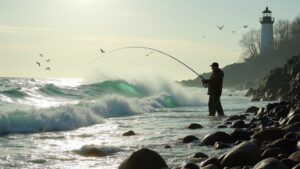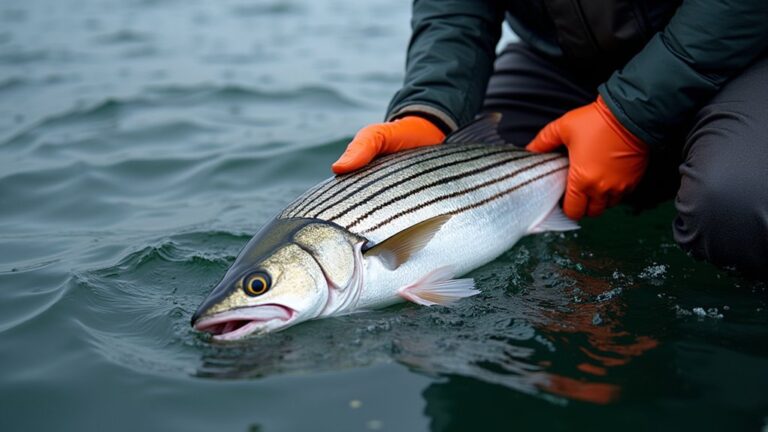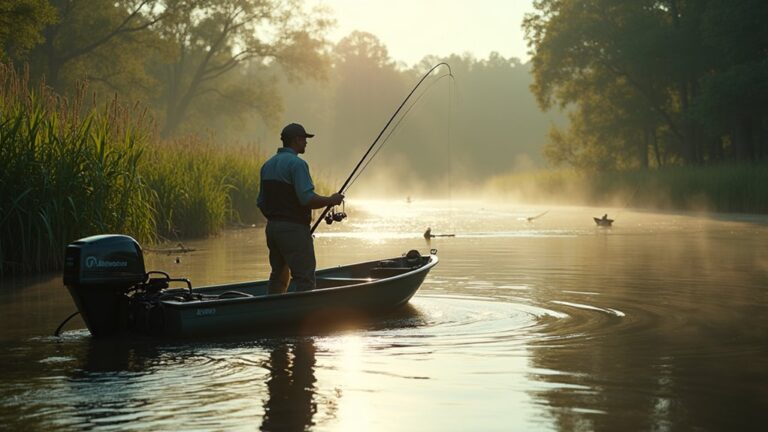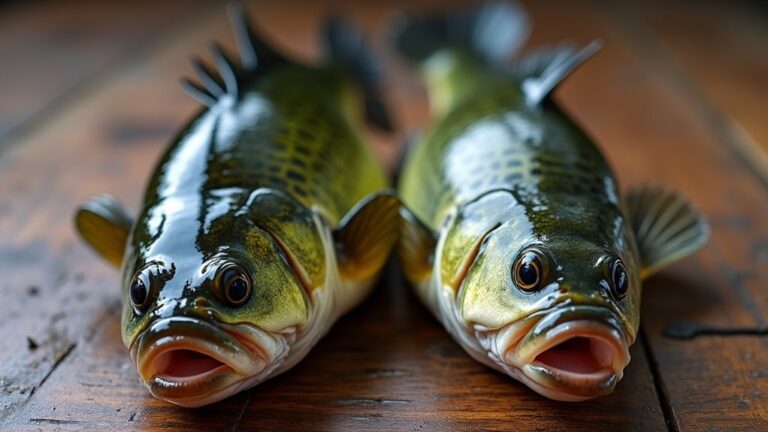You’ll chase migrating stripers staging on tidal flats and river mouths at dawn and dusk, while blitzing bluefish slam bait schools with fast, aggressive runs—work birds and surface boils and use metal spoons, fast plugs, or live bait. Probe rocky headlands and mussel beds for tautog and porgies with clams, squid, or small jigs. Watch tides, temps, and move with the fish; keep light saltwater gear, leaders, and pliers handy, and more tips follow.
Important Takeaways
- Striped bass dominate fall runs: fish tidal rivers, flats, and channel edges at dawn and dusk for topwater and soft-plastic bites.
- Bluefish chase bait schools nearshore: use metal spoons, fast plugs, and aggressive retrieves around birds and surface activity.
- Tautog and porgies concentrate on rocky headlands, mussel beds, and hard bottom; fish slowly with clams, squid, or bloodworms.
- Match presentation to cooling water: early topwater, midmorning plastics/divers, then deeper plugs or jigs as bait tightens.
- Plan around tides, wind, and water temps; carry corrosion-resistant gear, leaders for blues, and two-hook rigs for rock fishing.
Fall Run: Striped Bass and Where to Find Them
Where are the stripers moving this fall? You’ll find striped bass staging along tidal rivers and inshore flats as the fall run pushes fish from shallow feeding zones toward deeper channels and river mouths.
In the lower Hudson River you can expect a steady, productive bite as fish transition into fall-to-winter holding areas.
You’ll want to watch bite timing closely — early morning and late afternoon windows often light up, but tides and bait moves dictate sudden shifts.
Move with the fish: work flats on incoming tides, then shift to channels and holes as water cools.
Change presentations to match bait activity, and you’ll capitalize on the concentrated fall run action before winter sets in.
Always wear a properly fitting PFD and carry basic safety gear whenever you fish from a kayak.
Bluefish Action: Tactics for Fast, Aggressive Fish
As stripers move toward channels and river mouths you’ll often find bluefish hot on the same bait — but their approach is nothing like the steadier bass bite.
You’ll chase bait schools inshore, watching birds and surface commotion for feeding signs, then punch casts into the chaos.
Expect a fast bite window: they pounce, you strip hard and fast to trigger strikes.
Use sturdy light-to-medium saltwater tackle with wire or heavy leader to handle toothy jaws and sudden runs.
Favor metal spoons, in-line spinners, and fast plugs that mimic fleeing baitfish, retrieved aggressively.
Work packs of fish by covering water quickly; shorter, violent retrieves often outproduce slow presentations.
Stay ready for abrupt turns and be decisive when bluefish lock on.
Consider packing a lightweight, sensitive setup with 24-ton graphite to help detect fast, subtle strikes and maintain comfort during long days on the water.
Tautog and Porgies: Structure Fishing Essentials
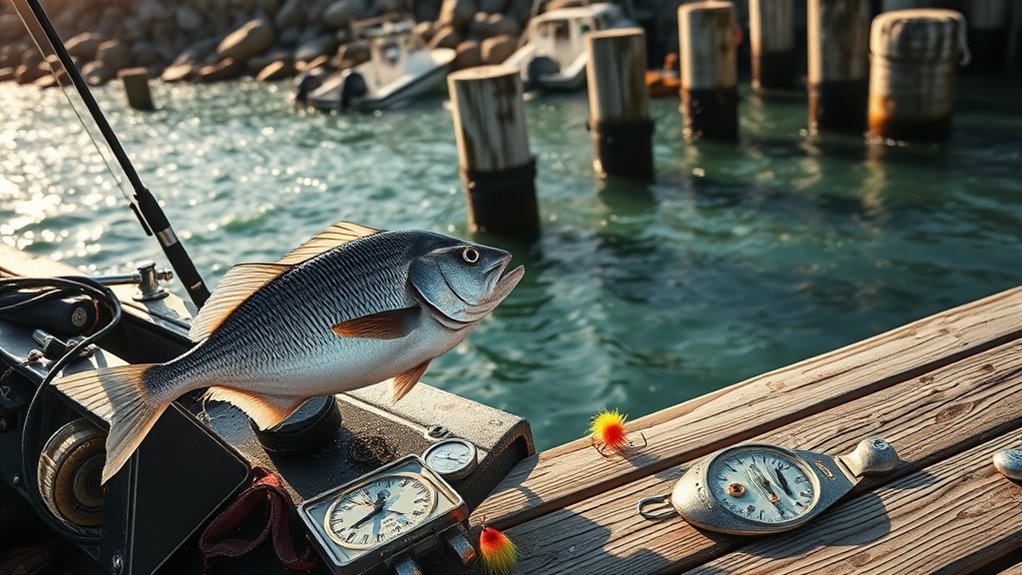
Looking for steady action around rocky headlands and mussel beds? You’ll target tautog and porgies by focusing on structure fishing—rocks, mussel beds and hard bottom concentrate these fish in fall.
Work shorelines like Weekapaug, Quonochontaug, Charlestown and Galilee Channel, probing holes and edges. Use small natural baits—squid, clams, sandworms, bloodworms or tiny fish pieces—to match mouths and add scent.
For porgies, switch rigs between one- and four-hook setups; try two-hook rigs when action slows to boost scent, or single hooks for bigger fish. Don’t ignore artificials—small diamond jigs, epoxy jigs and bucktails can trigger bites when naturals fail.
Keep gear light, check bottom frequently, and fish slowly to stay tight to structure. Reef-associated species often rely on shelter and reef biodiversity for protection and food.
Best Baits and Lures for Cooler Water
Shifting into cooler fall water, you’ll want baits and lures that match slower fish metabolisms and tighter bait schools: think topwater plugs at dawn for stripers, then swap to soft plastics or diving plugs by midmorning, use deeper-running lures near thermoclines for salmon or lakers, downsize jigs or drop-shot rigs for crappies in backwaters, and stick with small natural baits or Fishbites on one- to two-hook rigs for porgies over rocky bottoms. Target bluefish by pairing live baiting with cast-and-retrieve lures around bait schools and moving along edge lines and pockets near structure. Focus retrieves: slow, twitchy presentations for cold fish, slightly faster for aggressive blues. Carry divers, sinking plastics, small jigs, and a selection of natural baits to switch quickly as conditions dictate. For easy transport and a stable platform when fishing shallow flats, consider a lightweight kayak with excellent stability for confidence on the water.
Tides, Weather, and Timing Your Trips
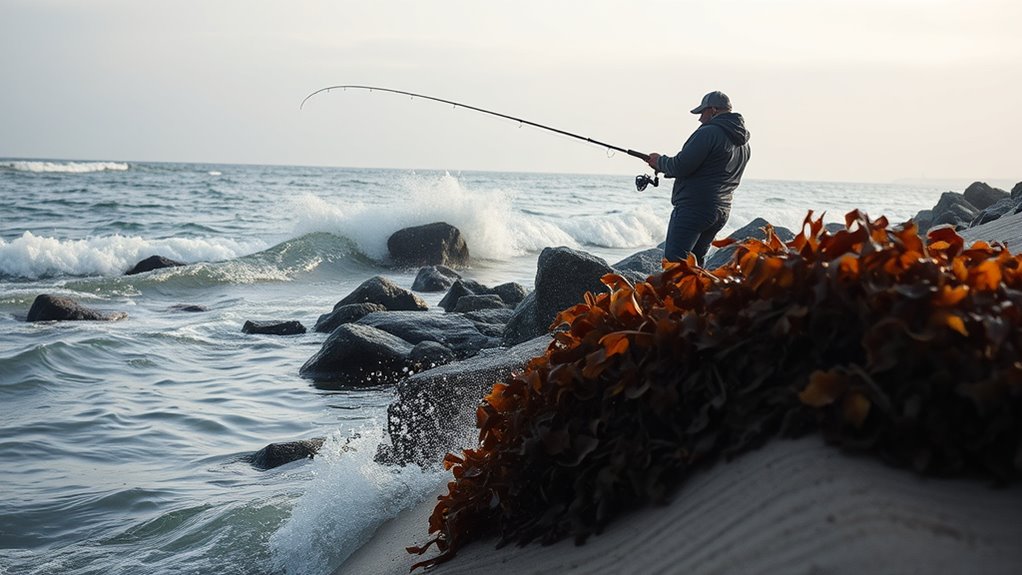
When should you go and where you drift will decide most fall trips—tides, wind and water temps set the table for stripers, blues and pelagics, so plan around tide windows and local bite timing rather than a fixed calendar. You’ll track tides and weather, watch water temps, and pick dawn or dusk bite windows. In the Hudson and other estuaries local timing matters; observe when stripers feed. Offshore, pelagic species follow temperature breaks and dolphins, so adjust location and timing. Use tide tables, forecasts, and recent reports to shape trips. Balance sea state and wind for safety and bite quality. Prepare gear ahead of trips to save time on the water and reduce on-the-water complications with corrosion-resistant equipment.
| Tide phase | Best timing | Target species |
|---|---|---|
| Flood | Early morning | Stripers |
| Ebb | Dusk | Bluefish |
| Slack | Midday | Pelagic species |
| Mixed | Variable | Mixed schools |
Gear Checklist for Inshore and Nearshore Fall Trips
You’ve watched tides, weather, and bait activity — now outfit yourself for the conditions you’ll find close to shore.
For fall saltwater inshore and nearshore trips, pack light rods (6–8ft medium-action), corrosion‑resistant spinning reels spooled with 10–30lb braid, and fluorocarbon leaders. Bring a concise gear checklist: epoxy jigs, small Pro Tails, surface Erasers for matching hatch; pink glow jigs and harnesses if you stray offshore; two‑hook porgy rigs plus single‑hook options for rock piles and mussel beds. Include a fishfinder/side‑scan for structure, polarized sunglasses, pliers, leader scissors, and a compact first‑aid kit. Don’t forget extra terminal tackle, bait bags for peanut bunker and silversides, and a rain shell—you’ll react fast when birds mark feeding shoals. Lake St. Clair is one of Michigan’s premier bass destinations with consistent trophy smallmouth year‑round presence.
Top New England Fall Hotspots
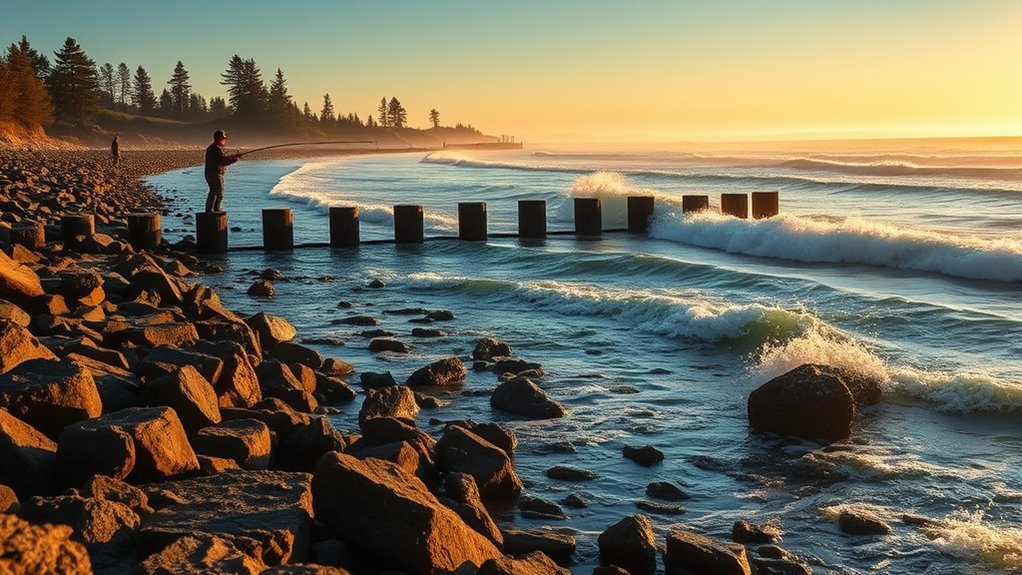
Looking for the best fall fishing spots in New England? You’ll want to chase areas where bird activity, bait schools, and temperature breaks converge. Offshore jigging for bluefin tuna near slicks pays off if you run long-range trips and watch for mackerel and dolphin activity. Inshore, focus on bait schools that feed striped bass and bluefish—dawn topwater action switches to soft plastics as light builds. Stellwagen Bank remains a prime mid-channel destination for mixed pelagics and groundfish; monitor surface shows and plan heavy-gear trips. Here are three hotspots to target:
- Stellwagen Bank — prime for mixed pelagics, bird activity, and bait schools.
- Block Island Sound — offshore jigging grounds and bluefin access.
- Cape Cod inshore flats — striped bass feeding on concentrated bait schools.
Always verify local size, bag, and seasonal regulations before you fish to stay compliant with fishing regulations and protect local populations.
Final Thoughts
You’ve got a solid plan for fall saltwater fishing in New England — now get out there and fish it. Focus on striped bass in the run, expect fast bluefish action, and target tautog and porgies around structure. Use cool-water baits and lures, watch tides and weather, and pack the right gear for inshore or nearshore trips. Hit the hotspots at the peak times, stay flexible, and enjoy the seasonal bite.

